Announcement®
Help develop Pair Go®
into a world-wide pair game.
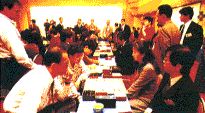
The pair game from Japan
Pair Go® is the mixed doubles of go: a two-on-two pair game in which the pairs are male-female. It was developed as a new way to have fun.
Rengo, in which two or more people play on each side, has been around for a long time. Why not formalize it as a game for mixed pairs? Wouldn't that make the game more enjoyable for more people? This was the idea that gave Pair Go its start, and was the aim of forming the Japan Pair Go Association.
At present, contract bridge is the pair game with the largest number of players world-wide. Our dream and goal is to bring Pair Go up to same level as bridge. Go is a mature game. By offering an easier way to enjoy the fascination and depth of go, Pair Go has the potential to develop into one of the world's best-loved intellectual sports.
The Japan Pair Go Association is currently seeking supporting members. The history of Pair Go is just beginning. Why not join the other Association members in the friendly work of developing Pair Go?
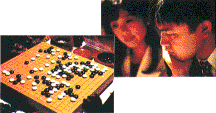
Two people tracing out 10 to the 800th strategies.
Pair Go® is an intellectual doubles that transcends logic and will never lose its interest.
Computer game software has reached the 2-dan level in shogi, and in chess computers are already said to be better than humans, but go software is still no stronger than about 10 kyu. This is because of the depth of the game of go. The number of combinations in the game of go is said to be about 10 to the 800th power, putting it essentially beyond the reach of theory. That is also why go is referred to as a game that stimulates the right hemisphere of the brain; that reflects one's sensibilities and outlook on life.
he fascination of Pair Go lies in playing this deep game two-against-two. What gives Pair Go its special flavor is the rule that forbids consultation about the moves, by word or by gesture, during the game. The woman on the black side plays the first move, the woman on the white side plays the second move, the man on the black side plays the third move, and the man on the white side plays the fourth move. This cycle repeats until the end of the game, and the partners cannot consult in any way before the end. Besides sensing your opponents' strategy, you also have to see the meaning of your partner's moves. The tactics can become quite complicated. The battle rages above the theoretical plane. It becomes a work of art created on the board by a mingling of the two players' senses, a mystery without an end.
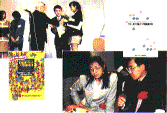
The International Amateur Pair Go Championship
decides the world's top amateurs.
Professional sensitivities clash at the Professional Pair Go Championship. Interest in Pair Go® is growing at an accelerating pace.
The two amateur and professional tournaments organized by the Japan Pair Go Association are turning into major forces that show people how enjoyable and interesting Pair Go is and attract more players to the game.
For amateurs, the International Amateur Pair Go Championship started in 1990. Since then the number of pairs entering the qualifying rounds has grown every year. It is now recognized both in Japan and by go fans throughout the world as the tournament that determines the world's top amateurs.
The First Professional Pair Go Championship was held in 1994 (the final game in January 1995) as a charity tournament commemorating the founding of the Japan Pair Go Association. The sixteen competing pairs were all leading professional players from the Nihon Kiin and Kansai Kiin; the list of participants by itself was enough to attract the notice of any go fan.
The Japan Pair Go Association plans to continue holding both tournaments on a regular basis. Building around these two events, we hope to expand Pair Go circles by making the appeal of Pair Go more widely known.

Pair Go, together with go itself,
is quietly gaining momentum in Europe,
America, and other parts of the world.
In particular, the number of women who play Pair Go is increasing annually.
European players were first exposed to Pair Go when it was included as an exhibition event at the 36th European Go Congress in 1992 (Canterbury, England). This came about because the players who participated in the International Amateur Pair Go Championship had reported that it was "thrilling and interesting." At the next European Go Congress in Prague in the Czech Republic, Pair Go was included as a formal event. It was also demonstrated on an exhibition basis at the U.S. Go Congress that year, and was well received.
Since its introduction at these events, Pair Go has won a secure place among the general go-playing public, and especially among women, as a casual intellectual sport that men and women can enjoy together. Together with the game of go itself, Pair Go is quietly gathering momentum.
Needless to say, the reason that Pair Go has been so readily accepted is the long-standing efforts of the Nihon Kiin to promote the spread of go overseas, at such facilities as the European Go Center in the Netherlands and the South American Go Center in Brazil. The Japan Pair Go Association also hopes to establish Pair Go salons in cities around the world, and will work actively to promote Pair Go, along with the game of go itself.
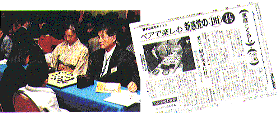
Propelled by Pair Go, the day when Japan's go-playing
population reaches 30 million is not just a dream.
Of the world's estimated 25 million go players in 50 countries, almost all are men, but the appearance of Pair Go has begun to change things. The number of women players is increasing, because of Pair Go. This can be particularly seen in the International Amateur Pair Go Championship. Women who hesitated to enter tournaments by themselves are flocking to the pair game. The number of entries increases year by year.
Pair Go is also spreading go among the younger generation. There seem to be more cases in which parents encourage their children to play, either to train their minds or just for family enjoyment. To broaden the base of the go population and to spread Pair Go into the home, the Japan Pair Go Association has decided to donate go boards and stones to primary and middle schools. In the near future, the sight of children playing Pair Go may become as common as the sight of them kicking a soccer ball around.
Pair Go is sure to bring more players to the game, because it makes the game immediately interesting to women, children, and beginners. There can be no doubt that the result will be an explosive increase in the go-playing population. Look at Korea, which has nearly 10 million players, about 25% of their population of 40 million. Given that example, a go-playing population of 30 million in Japan is no mere dream. When that mark is reached, the world's go-playing population will of course be many times 25 million.
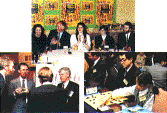
The pair game for married couples,
for lovers, for parents and children.
Pair Go® parties and other activities are creating a new type of intellectual social life for men and women.
Pair Go has engendered a new kind of time, elegant and intellectual, for communication between the sexes. In Europe and America, where husbands and wives often attend parties together, it is becoming particularly popular as a new game in which the two sexes can socialize. It can be enjoyed by married couples, parents and children, or just friends. Even beginners can enjoy it, because, as has been pointed out, there is twice as much fun in winning, and only half as much responsibility in losing. It's a partnership game, in which the key point is how well the stronger partner can look after the weaker. This may be what makes Pair Go such a good match for mixed parties and family gatherings.
Besides holding parties and other events for its members, the Japan Pair Go Association hopes to make a broad appeal for people to enjoy Pair Go and include it in their lives.

